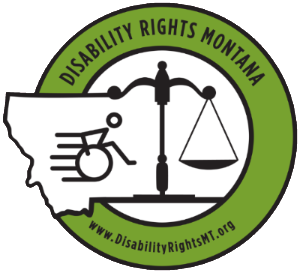
Disability Rights Montana, the state’s federally mandated Protection and Advocacy system, is sounding the alarm over the devastating impact of the proposed FY 2026 federal budget, which would slash funding for critical disability rights programs in Montana in half or more.
Fifty years ago, Congress mandated the creation of independent Protection and Advocacy systems in every state and territory in response to abuses and deplorable conditions found in state institutions housing people with intellectual and developmental disabilities. Instead of creating a new federal agency to do this work, Congress funded local non-profits with boards of people with disabilities, their family members, and other knowledgeable professionals from the state to decide how to best protect the rights of people with disabilities in their state. Disability Rights Montana is this organization for Montanans.
President Trump’s proposed budget slashes funding of several key Protection and Advocacy programs, including those that protect individuals with mental illness, and those with physical, sensory, and learning disabilities. Disability Rights Montana is designated by the Governor to protect people with significant mental illness like those detained at Montana State Hospital in Warm Springs. Funding for work in the specific area of mental illness would be cut by nearly 65%, while programs to protect most other people with disabilities would be completely eliminated in the President’s proposed budget. This budget defunds independent oversight of therapeutic settings such as group homes, hospitals, and nursing homes. It defunds work to stop substandard services for Montanans who are Deaf, blind, and physically disabled. It defunds efforts to improve education services for neurodiverse students with ADHD, Autism, and dyslexia. It defunds assistance provided to workers with disabilities looking to go back to work. And it defunds advocacy to remove barriers people with disabilities face when they try to register to vote and cast their ballot.
The Social Security Administration has not yet announced what it plans on cutting in its budget, but it does fund two Protection and Advocacy programs which could result in even deeper reductions if the Social Security Administration funded programs are also eliminated.
Most of what Disability Rights Montana does is behind the scenes and hidden from the public because the organization spends time in places the public cannot go. Their special federal authority allows access into jails and hospitals to investigate abuse and neglect, monitor schools to protect access to education, and go into people’s homes to assess the in-home healthcare they are receiving. As an example of work that would be lost in Montana, in 2025 Disability Rights Montana has already:
- Monitored over 100 residential and day service programs serving people with intellectual and developmental disabilities from Libby to Plentywood and Havre to Dillon.
- Educated more than 800 individuals with intellectual and developmental disabilities about their rights and learned from them about the quality of their services.
- Monitored schools in the Flathead Valley to assess how well they prepare students with disabilities for life after high school.
- Documented inaccessible government buildings in Great Falls, Helena, Missoula, Bozeman, and Butte.
- Engaged hundreds of renters with disabilities and landlords across the state to identify and address barriers to housing and affordability.
- Educated state legislators on the impact their bills would have on Montanans with disabilities.
- Drafted and successfully advocated for a new law creating community-based supports for people with dementia, preventing unnecessary institutionalization in the state hospital.
- Stopped legislation that would have disenfranchised the lives of thousands of Montanans with mental illness, intellectual disabilities, traumatic brain injuries, and other cognitive disabilities.
- Joined partners to protect Medicaid for Montanans with disabilities.
- Continued litigation in two system reform lawsuits filed last year: one to stop the diversion of funds from special education classrooms, and another to restore voting rights to patients at the Montana State Hospital.
- Filed two new system reform lawsuits: one to stop schools from unlawfully ending education at age 18 for students with disabilities, and another to block a new law that restricts absentee voting access.
“These cuts would be catastrophic for Montanans with disabilities,” said David Carlson, Executive Director of Disability Rights Montana. Disability Rights Montana’s monitoring, investigation, and advocacy has revealed widespread issues with inadequate state delivered and funded healthcare, inaccessible public buildings, inadequate school services, and barriers to housing and voting in Montana. These systemic gaps reflect a broad lack of enforcement and investment in legally required disability rights. “For example, Montana offers fewer Medicaid benefits to our residents compared to other states, and the services we do offer struggle to reach the Montanans who need them most because we are spread out across a vast geography and served by an underdeveloped workforce,” explained Carlson. “This budget eliminates the only independent oversight many of our state and private programs have.”
“We uncover abusive and neglectful treatment of government agencies and private contractors, show them how they should improve, and when they resist adopting the changes needed, we have the expertise to educate legislators and bring systemic litigation to protect Montanans with disabilities.” Carlson reports that the Protection and Advocacy program reductions and eliminations would push Montana even further behind other states and leave thousands with disabilities who are being hurt and denied quality services without any means to stop the illegal harm they face.
The budget will not only defund the work Disability Rights Montana is doing across the state, it defunds protections for people with disabilities in every state and territory across the nation. If enacted, these cuts would save only $110,000 million nationally, but it would dismantle meaningful, locally controlled oversight that has proven effective for half a century.


